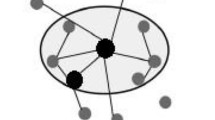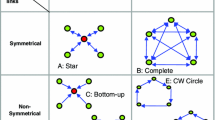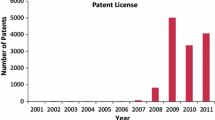Abstract
Innovation network formulated by the collaborations between entities (firms, universities and research institutes) facilitates the technology spillovers, which usually act as a key factor that boosts indigenous innovation capability. This study analyzes the collaborative innovation network from both intra- and inter-regional dimensions. We use the Chinese biomedical patent co-inventing data between entities to construct the intra- and inter-regional collaborative innovation networks, and examine how they generate the spillover effect by moderating the relationship between R&D input and output, as well as how they moderate the technology spillovers from overseas countries. The empirical study shows that collaborative innovation network generates a significant moderating effect on the relationship between R&D personnel and innovation output, while this effect is insignificant for R&D investment. In the intra-regional collaborative innovation network dimension, clustering coefficient and network density generate positive moderating effects by amplifying the positive relationship between R&D personnel and innovation output, network density also positively moderates the correlation between overseas technology spillover and innovation output; In the inter-regional dimension, only the clustering coefficient positively moderates the relationship between R&D personnel and innovation output. Our study is also relevant to policy makers.





Similar content being viewed by others
Notes
The robustness section tried 4 and 6 years window lengths, which lead to generally the same empirical results.
References
Abramovitz, M. (1986). Catching up, forging ahead, and falling behind. Journal of Economic History, 46(2), 385–406.
Acharya, R. C., & Keller, W. (2009). Technology transfer through imports. Canadian Journal of Economics, 42(4), 1411–1448.
Ai, C. R., & Norton, E. C. (2003). Interaction terms in logit and probit models. Economics Letters, 80(1), 123–129.
Almeida, P., & Kogut, B. (1999). Localization of knowledge and the mobility of engineers in regional networks. Management Science, 45(7), 905–917.
Bereskin, F. L., Campbell, T. L., & Hsu, P. H. (2016). Corporate philanthropy, research networks, and collaborative innovation. Financial Management, 45(1), 175–206.
Blundell, R., Griffith, R., & Van Reenen, J. (1995). Dynamic count data models of technological innovation. Economic Journal, 105(429), 333–343.
Branstetter, L., & Chen, J. R. (2006). The impact of technology transfer and R & D on productivity growth in Taiwanese industry: Microeconometric analysis using plant and firm-level data. Journal of the Japanese and International Economies, 20(2), 177–192.
Chen, Z. F., & Guan, J. C. (2010). The impact of small world on innovation: An empirical study of 16 countries. Journal of Informetrics, 4(1), 97–106.
Chen, K. H., & Guan, J. C. (2011). Mapping the innovation production process from accumulative advantage to economic outcomes: A path modeling approach. Technovation, 31(7), 336–346.
Chen, X., & Sun, C. (2000). Technology transfer to China: Alliances of Chinese enterprises with western technology exporters. Technovation, 20(7), 353–362.
Cheung, K., & Lin, P. (2004). Spillover effects of FDI on innovation in China: Evidence from the provincial data. China Economic Review, 15(1), 25–44.
Coe, D. T., & Helpman, E. (1995). International R&D spillovers. European Economic Review, 39(5), 859–887.
Cohen, W. M., & Levinthal, D. A. (1989). Innovation and learning: The two faces of R&D. Economic Journal, 99(397), 569–596.
Cohen, W., & Levinthal, D. (1990). Absorptive capacity: A new perspective on learning and innovation. Administrative Science Quarterly, 35(1), 128–152.
Correa, C. (1998). Argentina’s national innovation system. International Journal of Technology Management, 15(6), 721–760.
Di Cagno, D., Fabrizi, A., Meliciani, V., & Wanzenbock, I. (2016). The impact of relational spillovers from joint research projects on knowledge creation across European regions. Technological Forecasting and Social Change, 108, 83–94.
Fan, P. P. (2014). Innovation in China. Journal of Economic Surveys, 28(4), 725–745.
Fleming, L., King, C. I. I. I., & Juda, A. I. (2007). Small worlds and regional innovation. Organization Science, 18(6), 938–954.
Fleming, L., & Marx, M. (2006). Managing creativity in small worlds. California Management Review, 48(4), 6–27.
Frietsch, R., & Grupp, H. (2006). There is a new man in town: The paradigm shift in optical technology. Technovation, 26(1), 463–472.
Furman, J. L., Porter, M. E., & Stern, S. (2002). The determinants of national innovative capacity. Research Policy, 31(6), 899–933.
Gao, X., Guan, J., & Rousseau, R. (2011). Mapping collaborative knowledge production in China using patent co-inventorships. Scientometrics, 88(2), 343–362.
Griliches, Z. (1990). Patent statistics as economic indicators: A survey. Journal of Economic Literature, 28(4), 1661–1707.
Grossman, G., & Helpman, E. (1991). Innovation and growth in the world economy. Cambridge, MA: MIT Press.
Guan, J. C., Zhang, J. J., & Yan, Y. (2015). The impact of multilevel networks on innovation. Research Policy, 44(3), 545–559.
Gulati, R. (1999). Network location and learning: The influence of network resources and firm capabilities on alliance formation. Strategic Management Journal, 20(5), 397–420.
Gulati, R., Sytch, M., & Tatarynowicz, A. (2012). The rise and fall of small worlds: Exploring the dynamics of social structure. Organization Science, 23(2), 449–471.
Hu, A. G. Z., & Jefferson, G. H. (2002). FDI impact and spillover: Evidence from China’s electronic and textile industries. World Economy, 25(8), 1063–1076.
Ivarsson, I., & Alvstam, C. G. (2005). Technology transfer from TNCs to local suppliers in developing countries: A study of AB Volvo’s truck and bus plants in Brazil, China, India, and Mexico. World Development, 33(8), 1325–1344.
Karaca-Mandic, P., Norton, E. C., & Dowd, B. (2012). Interaction terms in nonlinear models. Health Services Research, 47(1), 255–274.
Katrak, H. (1998). Economic analyses of industrial research institutes in developing countries: The Indian experience. Research Policy, 27(4), 337–347.
Katz, J. (2001). Structural reforms and technological behavior, the sources and nature of technological change in Latin America in the 1990s. Research Policy, 30(1), 1–19.
Keller, W. (2002). Geographic localization of international technology diffusion. American Economic Review, 92(1), 120–142.
Kotabe, M., Sahay, A., & Aulakh, P. S. (1996). Emerging role of technology licensing in the development of global product strategy: Conceptual framework and research propositions. Journal of Marketing, 60(1), 73–88.
Krätke, S. (2010). Regional knowledge networks: A network analysis approach to the interlinking of knowledge resources. European Urban and Regional Studies, 17(1), 83–97.
Lan, P., & Young, S. (1996). International technology transfer examined at technology component level: A case study in China. Technovation, 16(6), 277–286.
Leonard-Barton, D. (1992). Core capabilities and core rigidities: A paradox in managing new product development. Strategic Management Journal, 13, 111–125.
Liu, W. (1995). International technology transfer and development of technological capabilities: A theoretical framework. Technology in Society, 17(1), 103–120.
Liu, Z. Q. (2002). Foreign direct investment and technology spillover: Evidence from China. Journal of Comparative Economics, 30(3), 579–602.
Liu, X., & Wang, C. (2003). Does foreign direct investment facilitate techno- logical progress? Evidence from Chinese industries. Research Policy, 32(6), 945–953.
Lu, L. C., & Huang, R. (2012). Urban hierarchy of innovation capability and inter-city linkages of knowledge in post-reform China. Chinese Geographical Science, 22(5), 602–616.
Meyer, K. (2001). International business research in transition economies. In Thomas L. Brewer & Alan M. Rugman (Eds.), Oxford Handbook of International business (pp. 716–759). Oxford: Oxford University Press.
Naoto, J., Zhang, X., & Haruna, S. (2015). Trade patterns and international technology spillovers: Evidence from patent citations. Review of World Economics, 151(4), 635–658.
Niosi, J., Hanel, P., & Fiset, L. (1995). Technology transfer to developing countries through engineering firms: The Canadian experience. World Development, 23(10), 1815–1824.
Saxenian, A. (1994). Regional advantage. Cambridge, MA: Harvard University Press.
Schilling, M. A., & Phelps, C. C. (2007). Interfirm collaborative innovation networks: The impact of large-scale network structure on firm innovation. Management Science, 53(7), 1113–1126.
Schmoch, U. (2008). Concept of a technology classification for country comparisons. Report to the World Intellectual Property Organization (WIPO).
Shapiro, M. A., So, M., & Park, H. W. (2010). Quantifying the national innovation system: Inter-regional collaborative innovation networks in South Korea. Technology Analysis & Strategic Management, 22(7), 845–857.
Singh, J. (2005). Collaborative networks as determinants of knowledge spillover patterns. Management Science, 51(5), 756–770.
Sun, Y. F. (2002a). China’s national innovation system in transition. Eurasia Geography and Economics, 43(6), 476–492.
Sun, Y. F. (2002b). Sources of innovation in China’s manufacturing sector: Imported or developed in-house? Environment and Planning A, 34(6), 1059–1072.
Sun, Y. T., & Cao, C. (2015). Intra- and inter-regional research collaboration across organizational boundaries: Evolving patterns in China. Technological Forecasting and Social Change, 96, 215–231.
Sun, Y. F., & Du, D. B. (2010). Determinants of industrial innovation in China: Evidence from its recent economic census. Technovation, 30(9–10), 540–550.
Tian, X. (2007). Accounting for sources of FDI technology spillovers: Evidence from China. Journal of International Business Studies, 38(1), 147–159.
Verdolini, E., & Galeotti, M. (2011). At home and abroad: An empirical analysis of innovation and diffusion in energy technologies. Journal of Environmental Economics and Management, 61(2), 119–134.
Vishwasrao, S., Gupta, S., & Benchekroun, H. (2007). Optimum tariffs and patent length in a model of North–South technology transfer. International Review of Economics and Finance, 16(1), 1–14.
Wang, J., Baylis, K., & Mulder, P. (2015). Trade-facilitated technology spillovers in energy productivity convergence processes across EU countries. Energy Economics, 48, 253–264.
Wang, N., & Hagedoorn, J. (2014). The lag structure of the relationship between patenting and internal R&D revisited. Research Policy, 43(8), 1275–1285.
Winterscheid, B. C., & McNabb, S. (1994). Technology development and transfer across national and organizational borders: the case of AT&T network systems Europe. International Business Review, 3(4), 425–442.
Xu, B., & Wang, J. (1999). Capital goods trade and R&D spillovers in the OECD. Canadian Journal of Economics, 32(5), 1258–1274.
Yang, L., & Maskus, K. E. (2009). Intellectual property rights, technology transfer and exports in developing countries. Journal of Development Economics, 90(2), 231–236.
Young, S., & Lan, P. (1997). Technology transfer to China through foreign direct investment. Regional Studies, 31(7), 669–679.
Zhang, G. P., Duan, H. B., & Zhou, J. H. (2015). Small worldliness, Chinese culture and firm innovation performance: An empirical study based on patent collaboration data of China. Asian Journal of Technology Innovation, 23(2), 189–204.
Zhang, G. P., Duan, H. B., & Zhou, J. H. (2016). Investigating determinants of inter-regional technology transfer in China: A network analysis with provincial patent data. Review of Managerial Science, 10(2), 345–364.
Zhang, G. P., Guan, J. C., & Liu, X. L. (2014). The impact of small world on patent productivity in China. Scientometrics, 98(2), 945–960.
Zhang, G. P., & Zhou, J. H. (2016). The effects of forward and reverse engineering on firm innovation performance in the stages of technology catch-up: An empirical study of China. Technological Forecasting and Social Change, 104, 212–222.
Zhu, G. F., & Davidson Frame, J. (1987). Technology transfer within China. Journal of Technology Transfer, 11(2), 29–42.
Acknowledgements
Funding was provided by National Natural Science Foundation of China (71872169, 71810107004), National Social Science Foundation of China (15BGL027), University of Chinese Academy of Sciences (Y8540XX1P2), and Bureau of Planning and Strategy, Chinese Academy of Sciences (GHJ-ZLZX-2019-33-2).
Author information
Authors and Affiliations
Corresponding author
Appendix
Rights and permissions
About this article
Cite this article
Wang, C., Zhang, G. Examining the moderating effect of technology spillovers embedded in the intra- and inter-regional collaborative innovation networks of China. Scientometrics 119, 561–593 (2019). https://doi.org/10.1007/s11192-019-03084-1
Received:
Published:
Issue Date:
DOI: https://doi.org/10.1007/s11192-019-03084-1




